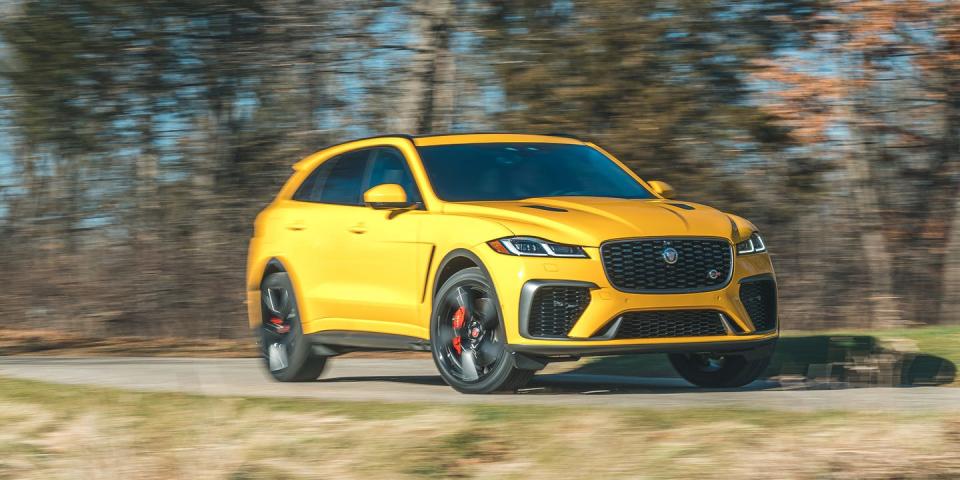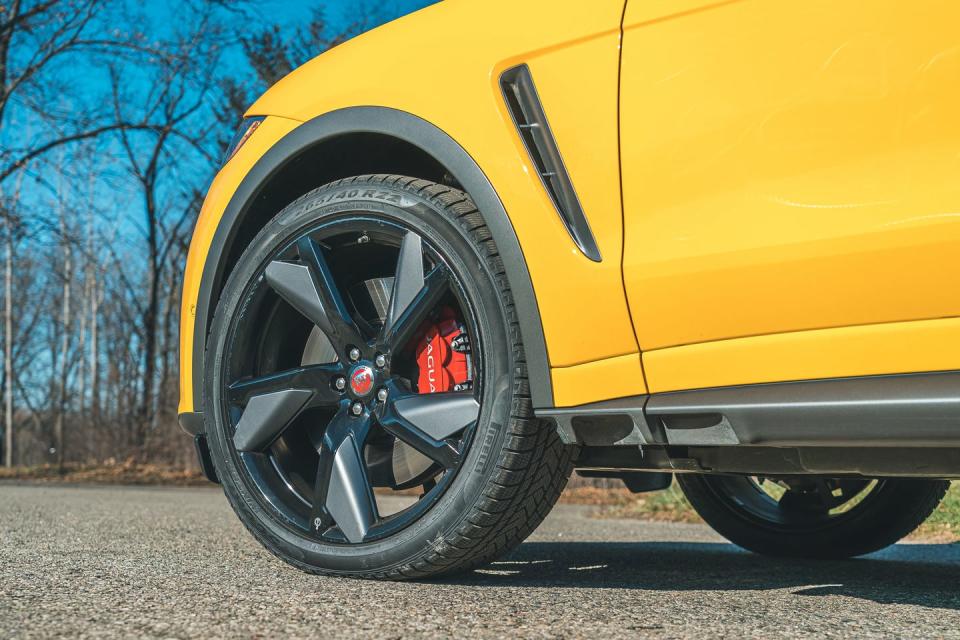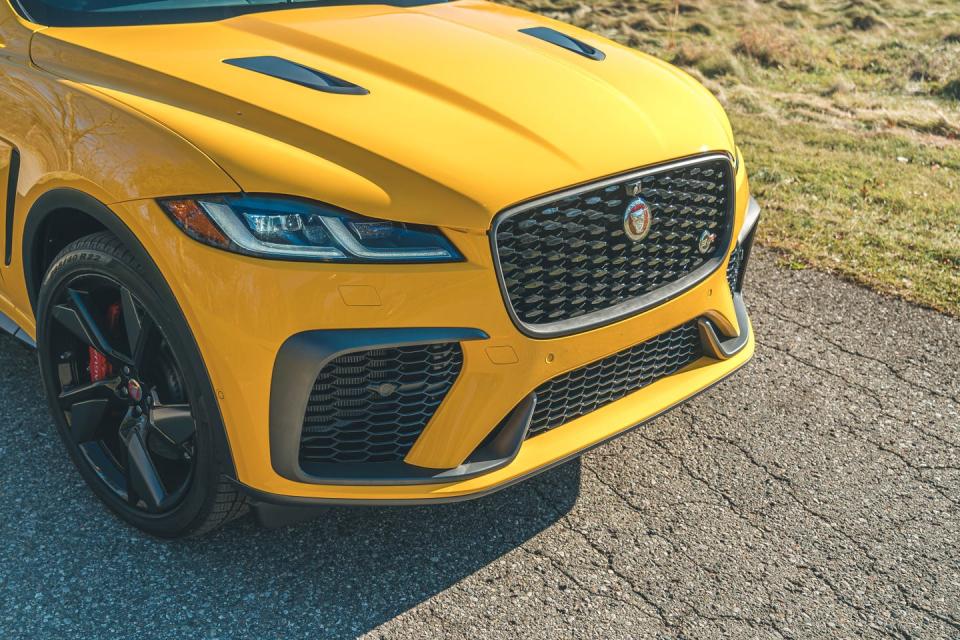Tested: 2021 Jaguar F-Pace SVR Is Fast and Doomed

UPDATE 4/26/22: This review has been updated with test results.
The auto industry never stops moving forward, and any new model faces a finite lifespan. Yet the revised F-Pace SVR is staring at an unusually premeditated demise, arriving after Jaguar announced its plan to transition to an all-electric lineup by 2025. In the midst of life, we are in death.
The demise of the F-type SVR means the F-Pace is now the only available Jaguar that was created by Jaguar Land Rover's Special Vehicle Operations division. (Yes, the SVR comes from SVO. Naturally.) As with lesser versions of the F-Pace, the changes are relatively modest, but they combine to sharpen the SVR's case against its elite rivals. Before getting into the differences, however, we should first celebrate the SVR's least changed feature and the continued star of the show—its supercharged V-8.

This is the 5.0-liter unit that JLR introduced in 2009, a development of the Ford-engineered AJ-V8 that made its debut in 1996. Given that the Ford factory in Wales that built it closed last year, we were expecting the engine to also die, but JLR instead opted to move production in-house to keep the venerable engine going for a few more years. It was recently fitted to the Defender, but this seems likely to be the last time it appears in a new Jaguar.
While the SVR's 550-hp output remains unchanged, it has been given a modest increase in peak torque to 516 pound-feet (up from 502). The standard eight-speed automatic transmission also gets updated software, which helps the revised SVR trim 0.3 second from its 60-mph run—dropping to 3.7 seconds compared to the 4.0 flat that we recorded in a test of a 2019 model—despite the new version gaining 154 pounds in mass. More than just getting a better launch, the updated model maintains that gap over its quarter-mile pass, now at 12.1 seconds at 116 mph. Somewhat ludicrously, that still doesn't put it at the sharp end of this ridiculously rapid segment, where faster rivals such as the BMW X3 M require only a smidge more than three seconds to hit 60 mph.

The Jaguar does score well on charisma, though. Its supercharged V-8 combines strong performance with a bristly soundtrack that surpasses the (mostly) six-cylinder competition on musicality while delivering its eight-cylinder top-end snarl without any digital augmentation. (The SVR's cabin even does without active noise cancellation to keep the aural experience unfiltered.) This SVR has lost the firecracker pops and bangs the pre-facelift version delivered when the throttle was lifted suddenly under load, and it always defaults to starting in the quieter of its two switchable exhaust modes, which should help improve relations with the neighbors. Still, the 87-decibel roar we recorded inside the cabin at full throttle isn’t exactly hushed, nor is 70 decibels at 70 mph exceedingly quiet for a luxury vehicle these days.
The SVR’s revised gearbox delivers impressively rapid shifts, especially under the direction of the satisfyingly weighty metal steering-wheel paddles, and it changes gears unobtrusively and intelligently in Drive. The transmission's Sport mode feels more aggressive than before, downshifting and holding low gears with minimal provocation and delivering an abrupt step-off when leaving the line. Unfortunately, Jaguar's new miniature gear selector lacks physically defined selections, springing back to a central position after drive or reverse is selected and thereby denying a sense of which (if any) gear is engaged.

Beneath the surface, SVO's engineering team gave the SVR a thorough makeover. We're told that every control module in the car is new and that every dynamic setting has been revised. But these tweaks have done nothing to alter the fundamental appeal of the car's relaxed athleticism. The SVR feels more compliant than the segment norm, especially over rough roads. Many fast SUVs try to replicate the behavior of lower, sleeker performance cars with firmed-up settings, but the F-Pace uses its suspension more intelligently to fill dips and absorb bumps, while still resisting roll and pitch impressively well. The development team says particular attention was paid to improving the SVR's ride over high-frequency bumps, although at lower speeds and over large-amplitude undulations the ride does feel firm. After all, the $1200 22-inch forged-aluminum wheels (21s are standard) on our test car do not allow for much tire sidewall.

Riding on Pirelli P Zero PZ4 summer tires, the SVR delivers both solid grip (0.89 g on the skidpad) and respectable-for-2022 levels of steering feel. The torque distribution of the all-wheel-drive system remains rear biased in all except the Ice and Snow mode, which defaults to a 50:50 split. In Dynamic, the most aggressive mode, the SVR is essentially rear-wheel drive, with torque only diverted forward when the rear tires run short on traction. Pushed hard, the SVR feels playful but never wayward, with an electronically controlled differential at the back sharpening responses and optimizing traction. It is also now possible to individualize many of the settings in Dynamic mode, which is represented by a race helmet on the central touchscreen. Drivers can choose between Comfort or Dynamic settings for the engine map, steering, dampers, and transmission, while keeping the rear-bias torque split.
A less welcome innovation is the arrival of electrically boosted brakes. We had no complaints with the trim 162-foot stop from 70 mph provided by the six-pot front calipers, but the new system minimizes pedal movement and felt harder to modulate at lower speeds—although we had mostly acclimatized after a few hours in the car.

Other changes are more welcome at the SVR’s $85,950 base price. Along with our example’s bold $4550 yellow paint, the updated exterior bodywork gains a little more visual aggression over the comparatively subdued pre-facelift model, with larger vents at the front and sleeker all-LED headlights. SVO says that revised aerodynamics reduce lift by a third and are responsible for the 3-mph increase in top speed (to 178 mph). The cabin benefits from a smart new dashboard, higher quality trim, and a redesigned center console that substitutes upmarket rotary heating controls for the old car's blue backlit plastic switchgear. The 11.4-inch curved-glass touchscreen is the centerpiece of JLR's new Pivi Pro infotainment system, which both looks and works far better than the old InControl Touch Pro setup. All told, the revisions make for a more cohesive and attractive environment at our test car’s final price of $97,379.
The F-Pace SVR remains a car that scores better on intangibles than measurable metrics. It's not the fastest or quickest ute in its segment, nor does it have the most finely tuned dynamics. But of all the muscled-up crossovers, it would be one of the easiest to actually live with. Jaguar won't be making vehicles like this for much longer. We will miss them when they are gone.

You Might Also Like

 Yahoo Autos
Yahoo Autos 